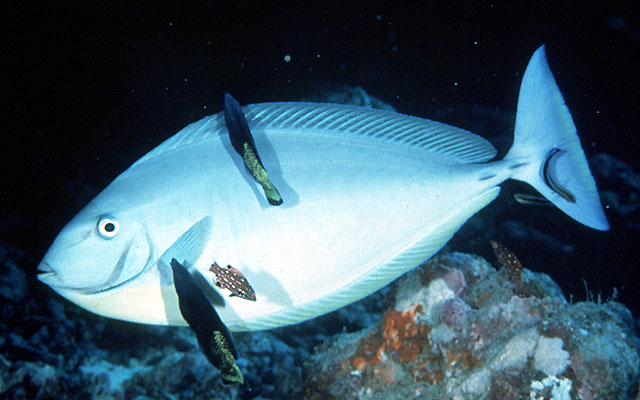| Acanthuridae (Surgeonfishes, tangs, unicornfishes), subfamily: Nasinae |
| 75 cm FL (male/unsexed); max. reported age: 44 years |
|
reef-associated; brackish; marine; depth range 0 - 150 m |
| Indo-Pacific: Red Sea and East Africa (Ref. 9710), including the Mascarene Islands (Ref. 37792) to the Hawaiian, Marquesas and Ducie islands, north to southern Japan, south to Lord Howe Island. |
|
Dorsal spines (total): 6-6; Dorsal soft rays (total): 26-29; Anal spines: 2-2; Anal soft rays: 27-30. This species is distinguished by the following characters: body moderately deep and compressed, its depth 2.6 to 3.2 times in standard length (SL); dorsal profile of body uniformly convex, without any bony horn-like projection or protuberance anteriorly on head; mouth small; incisiform teeth very small, somewhat pointed, finely serrate on edges, as many as 80 in upper jaw and 100 in lower jaw of large adults; continuous unnotched D VI (rarely V or VII),26-29; A II,27-30; pectoral-fin rays 17-18 (usually 17); pelvic fins I,3; caudal fin slightly emarginate in young, becoming truncate in adults; caudal peduncle slender, subcylindrical, with a pair of bony plates on each side that develop large sharp antrorse keels with age; body colour dark brownish grey, shading ventrally to yellowish (life colour may vary from dark brown to light blue-grey); edge of operculum and preopercle usually dark brown; dorsal and anal fins yellowish with faint diagonal brown bands and a blue margin; tongue black at lengths of 25 cm or more (Ref. 9808). |
| Inhabits clear lagoon and seaward reef slopes (Ref. 9710, 48637). Benthopelagic (Ref. 58302). Usually seen in large schools (Ref. 90102). Mainly diurnal, it feeds on zooplankton such as crab larvae, arrow worms, pelagic tunicates, and occasionally filamentous red algae. The species is never poisonous (Ref. 4795). Minimum depth reported taken from Ref. 128797. |
|
Least Concern (LC); Date assessed: 06 May 2010 Ref. (130435)
|
| harmless |
Source and more info: www.fishbase.org. For personal, classroom, and other internal use only. Not for publication.
